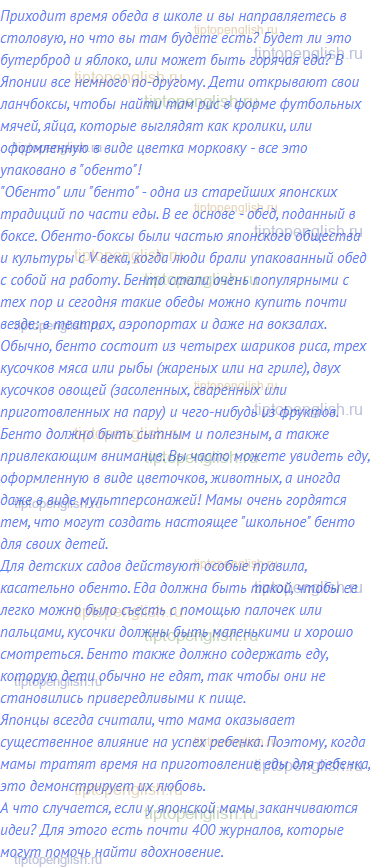ГДЗ Английский язык за 8 класс Ваулина - Spotlight - УчебникModule 2 – 2a – 3a
Think of three questions to ask about "obentos". Read, listen and check if you can answer them.
An obento, or bento, is one of the oldest food traditions in Japan. Basically, it is lunch served in a box. Obento boxes have been part of the Japanese society since the 5th century when people used to take a packed lunch with them to work. Bentos have become very popular since then and you can buy them almost anywhere nowadays at theatres, airports and even at train stations.
An obento usually consists of four parts rice, three parts meat or fish (fried or grilled), two parts vegetables (pickled, boiled or steamed) and one part fruit. It should be nourishing and healthy, but it must be appealing too. You often see food shaped like flowers, animals and sometimes even cartoon characters! Mothers take great pride in creating "school-bentos" for their children.
Nursery schools have established regulations for an obento. Food should be easy to eat with chopsticks or the fingers, portions should be small and it should be pleasing to the eye. It should also include food that the children would not normally eat so that they won't become a fussy eater.
The Japanese have always looked upon the mother as one of the main influences of a child's success. Taking time to prepare their children's food shows their love for them.
And what happens if a Japanese mum runs out of ideas? There are almost 400 magazines available to help them get inspired.
When have obento-boxes become popular in Japan? - Obento boxes have been part of the Japanese society since the 5th century when people used to take a packed lunch with them to work.
Who usually prepares obento for little kids? - Child's mother usually prepares an obento.
What do children usually find in lunchboxes? Children open their lunchboxes to find rice shaped like footballs, eggs that look like rabbits or flower-shaped carrots all packed up in an obento!
ГДЗ - "Spotlight - Учебник"
по предмету Английский язык за 8 класс.
Год издания
2019
Aвторы
Дули Д., Эванс В., Подоляко О.Е., Ваулина Ю.Е.
Задание
Think of three questions to ask about "obentos". Read, listen and check if you can answer them. Придумайте три вопроса об "обенто". Прочитайте, послушайте и проверьте, сможете ли вы ответить на них. It's lunchtime at school and you're heading for the canteen, but what will you have to eat? Will you have a sandwich and an apple, or maybe a hot meal? Things are a little different in Japan. Children open their lunchboxes to find rice shaped like footballs, eggs that look like rabbits or flower-shaped carrots all packed up in an obento! An obento, or bento, is one of the oldest food traditions in Japan. Basically, it is lunch served in a box. Obento boxes have been part of the Japanese society since the 5th century when people used to take a packed lunch with them to work. Bentos have become very popular since then and you can buy them almost anywhere nowadays at theatres, airports and even at train stations. An obento usually consists of four parts rice, three parts meat or fish (fried or grilled), two parts vegetables (pickled, boiled or steamed) and one part fruit. It should be nourishing and healthy, but it must be appealing too. You often see food shaped like flowers, animals and sometimes even cartoon characters! Mothers take great pride in creating "school-bentos" for their children. Nursery schools have established regulations for an obento. Food should be easy to eat with chopsticks or the fingers, portions should be small and it should be pleasing to the eye. It should also include food that the children would not normally eat so that they won't become a fussy eater. The Japanese have always looked upon the mother as one of the main influences of a child's success. Taking time to prepare their children's food shows their love for them. And what happens if a Japanese mum runs out of ideas? There are almost 400 magazines available to help them get inspired. Приходит время обеда в школе и вы направляетесь в столовую, но что вы там будете есть? Будет ли это бутерброд и яблоко, или может быть горячая еда? В Японии все немного по-другому. Дети открывают свои ланчбоксы, чтобы найти там рис в форме футбольных мячей, яйца, которые выглядят как кролики, или оформленную в виде цветка морковку - все это упаковано в "обенто"! "Обенто" или "бенто" - одна из старейших японских традиций по части еды. В ее основе - обед, поданный в боксе. Обенто-боксы были частью японского общества и культуры с V века, когда люди брали упакованный обед с собой на работу. Бенто стали очень популярными с тех пор и сегодня такие обеды можно купить почти везде: в театрах, аэропортах и даже на вокзалах. Обычно, бенто состоит из четырех шариков риса, трех кусочков мяса или рыбы (жареных или на гриле), двух кусочков овощей (засоленных, сваренных или приготовленных на пару) и чего-нибудь из фруктов. Бенто должно быть сытным и полезным, а также привлекающим внимание. Вы часто можете увидеть еду, оформленную в виде цветочков, животных, а иногда даже в виде мультперсонажей! Мамы очень гордятся тем, что могут создать настоящее "школьное" бенто для своих детей. Для детских садов действуют особые правила, касательно обенто. Еда должна быть такой, чтобы ее легко можно было съесть с помощью палочек или пальцами, кусочки должны быть маленькими и хорошо смотреться. Бенто также должно содержать еду, которую дети обычно не едят, так чтобы они не становились привередливыми к пище. Японцы всегда считали, что мама оказывает существенное влияние на успех ребенка. Поэтому, когда мамы тратят время на приготовление еды для ребенка, это демонстрирует их любовь. А что случается, если у японской мамы заканчиваются идеи? Для этого есть почти 400 журналов, которые могут помочь найти вдохновение.




